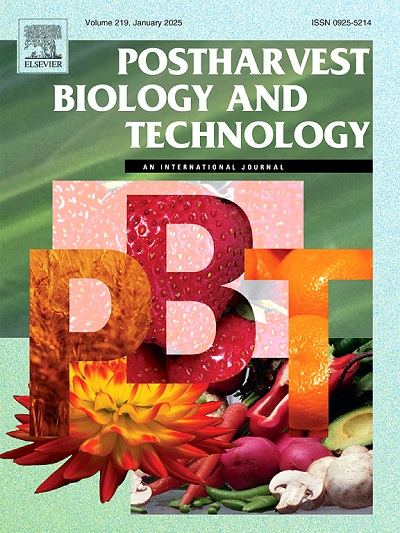MaWLIM2-MaZFP6转录调控模块直接抑制E3连接酶基因MaRZF1,调控香蕉果实高温抑制叶绿素分解代谢
IF 6.4
1区 农林科学
Q1 AGRONOMY
引用次数: 0
摘要
香蕉(Musa acuminata, AAA组)果实在超过24°C的高温(HTs)下成熟会阻止黄皮的发育,导致绿色成熟,这大大降低了其市场价值。我们最近的研究发现,HT诱导MaRZF1 (RING Zinc Finger 1)介导的MaSGR1 (keep - green 1)降解抑制叶绿素分解,但HT如何激活MaRZF1的表达完全不清楚。本研究确定了两个转录因子(TFs), MaWILIM2(广泛表达的LIM)和MaZFP6(锌指蛋白),作为MaRZF1启动子的潜在结合蛋白。MaWILIM2和MaZFP6在30°C绿熟果实中的表达量低于20°C黄熟果实。在香蕉果实中,过表达MaWLIM2和MaZFP6抑制了MaRZF1的表达,减轻了高温诱导的叶绿素分解代谢抑制。更重要的是,MaWLIM2与MaZFP6相互作用,协同抑制MaRZF1启动子活性。我们的研究结果表明,在香蕉果实中,MaWLIM2和MaZFP6形成了一个动态转录调控模块,可以抑制MaRZF1并控制hts抑制的叶绿素降解。这些发现增强了我们对温度胁迫导致果实质量下降的转录调控的理解,并有望有助于制定香蕉青熟管理策略。本文章由计算机程序翻译,如有差异,请以英文原文为准。
MaWLIM2-MaZFP6 transcriptional regulatory module directly represses E3 ligase gene MaRZF1 to regulate high temperature-suppressed chlorophyll catabolism in banana fruit
Banana (Musa acuminata, AAA group) fruit ripening at high temperatures (HTs) exceeding 24 °C prohibits the yellow peel development and leads to green ripening, which dramatically diminishes its marketability. Our recent study found that HT induced MaRZF1 (RING Zinc Finger 1)-mediated degradation of MaSGR1 (STAY-GREEN 1) to inhibit chlorophyll breakdown, but how HT activates MaRZF1's expression is completely unclear. The present study identifies two transcription factors (TFs), MaWILIM2 (widely expressed LIM) and MaZFP6 (zinc finger protein), as potential binding proteins for the MaRZF1 promoter. Both MaWILIM2 and MaZFP6 expression levels were lower in 30 °C green-ripened fruit than in 20 °C yellow-ripened fruit. In banana fruit, overexpressing MaWLIM2 and MaZFP6 suppressed MaRZF1 expression and mitigated chlorophyll catabolism inhibition caused by HTs. More importantly, MaWLIM2 interacted with MaZFP6 to synergistically repress the MaRZF1 promoter activity. Our findings demonstrate that MaWLIM2 and MaZFP6 form a dynamic transcriptional regulatory module that represses MaRZF1 and controls HTs-inhibited chlorophyll degradation in banana fruit. These findings enhance our understanding of transcriptional regulation in fruit quality decline due to temperature stress and are expected to aid in developing strategies to manage banana green-ripening.
求助全文
通过发布文献求助,成功后即可免费获取论文全文。
去求助
来源期刊

Postharvest Biology and Technology
农林科学-农艺学
CiteScore
12.00
自引率
11.40%
发文量
309
审稿时长
38 days
期刊介绍:
The journal is devoted exclusively to the publication of original papers, review articles and frontiers articles on biological and technological postharvest research. This includes the areas of postharvest storage, treatments and underpinning mechanisms, quality evaluation, packaging, handling and distribution of fresh horticultural crops including fruit, vegetables, flowers and nuts, but excluding grains, seeds and forages.
Papers reporting novel insights from fundamental and interdisciplinary research will be particularly encouraged. These disciplines include systems biology, bioinformatics, entomology, plant physiology, plant pathology, (bio)chemistry, engineering, modelling, and technologies for nondestructive testing.
Manuscripts on fresh food crops that will be further processed after postharvest storage, or on food processes beyond refrigeration, packaging and minimal processing will not be considered.
 求助内容:
求助内容: 应助结果提醒方式:
应助结果提醒方式:


